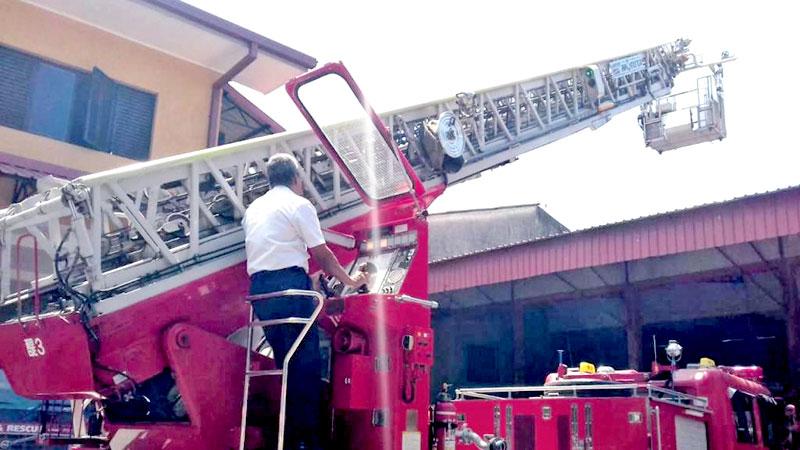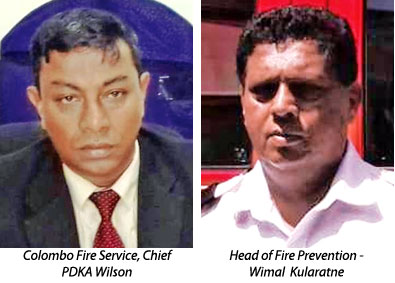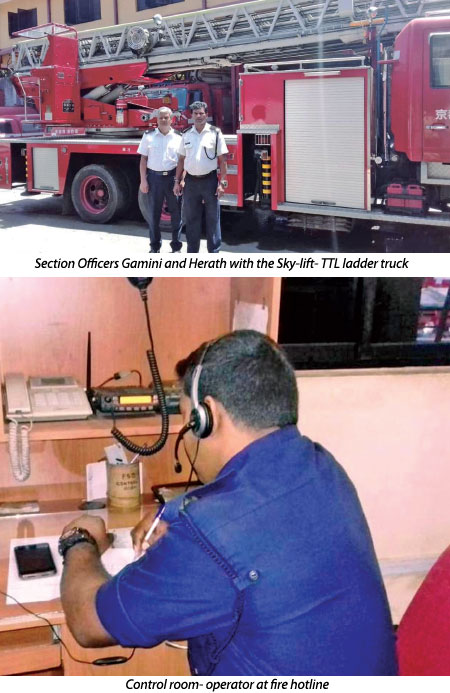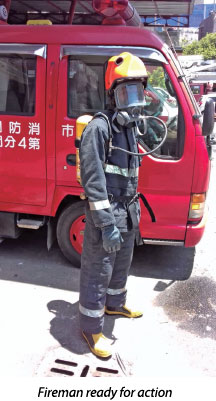
Colombo city is undergoing rapid transformation, with super high rise buildings dominating the skyline. The city has witnessed change not only in the form of buildings but also an increase in the number of people and vehicles entering the city, supplemented by growing tourist arrivals. One of the key services tasked with safety and responding to emergencies is the Colombo Fire Service Department, often referred to by city dwellers as the “fire brigade”.
 Located at Darley Road, Colombo 10 the Fire Service headquarters is a busy place, where firemen work in 24 hour shifts. I met the newly appointed Chief Fire Officer, P.D.K.A Wilson a veteran with 28 years of service, to discuss the challenges that face this vital service.
Located at Darley Road, Colombo 10 the Fire Service headquarters is a busy place, where firemen work in 24 hour shifts. I met the newly appointed Chief Fire Officer, P.D.K.A Wilson a veteran with 28 years of service, to discuss the challenges that face this vital service.
Fire Chief Wilson explains, “We are the first responders to any emergency related to fire and rescue. We focus much on preventing fires as well as mitigating them, as soon as they occur. At present, Colombo is seeing much development and new buildings are coming up. We have our Code of Practice and along with the guidelines of CIDA we implement fire safety regulations in all buildings. We classify structures according to the number of floors, i.e.low rise is 5 floors, medium rise 6 to 10 floors, high rise comprises 10-20 floors and super high rise buildings exceed 20 floors. When a building is in the process of being constructed we do an intermediate fire inspection, and once the building is complete, we do a final check and then decide to issue the Certificate of Conformity”.

We are now joined by senior firefighter and Head of Fire Prevention, Wimal Kularatne, who counts 38 years of service. Kularatne adds: “The new high-rise buildings pose new challenges to the fire brigade. As per global standards the emphasis on these new buildings is to have Internal Fire Fighting structures and mechanisms in place. These new towers have been built with firemen lifts (which operate on a separate electricity line) and other active and passive safety features. For example, the Nelum Tower (Lotus Tower) has a storage capacity of 480,000 litres of water that can be pumped out in case of fire, by connecting the hose of a fire engine’.
Geared for the future
Another feature used in high-rise rescues is the magnificent TTL (turn table tender truck) which has a fully automated ladder. Fire Chief Wilson explains “At present we have a few TTLs in service. They can reach up to 37 metres, depending on the building involved in the fire- and how close we can park. We can safely send our fire crew, after stabilizing this heavy truck. When launching the aerial ladder we have to think of the wind, the smoke condition, and the safety of our men. There are TTLs in the US, which could reach almost 100 metres, but these trucks come with 32 wheels and are not suitable for our city roads. We will not be able to drive these trucks and take bends in a hurry, as our roads are narrow. Thus, we have to opt for trucks that are practically suited to our roads.”
When asked about air mobility in fire rescue Chief Wilson smiles, ‘Yes helicopters play a vital role in mitigating a large inferno, especially, a chemical fire. They have the advantage of relaying real time details to the Fire Commander on the ground, who can then decide the course of action. But, in Sri Lanka, the Colombo city has only a few buildings that are equipped with a helipad- which can facilitate airborne rescue. On the other hand, we must remember that a helicopter can become a great fire hazard-- in the event it crashes due to heavy smoke, the aviation grade fuel will ignite the already raging fire, extending the disaster. Maintaining a helicopter costs lots of money”.
However, the Fire Chief is quick to point out, “We are in the process of using drone technology. We will train our staff to fly a drone and get real time visuals of fires, which can help our response”. The Section Chief, Kularatne, speaking about response time, says, “On receiving a fire alarm call, we dispatch our fire engines and bowsers within 60 seconds. As you know, traffic is increasing in Colombo, but the roads remain the same. We try our best to respond within eight minutes at daytime, and within three minutes at night time. We have five Sub Stations to enhance our response time, inside Colombo city. We hope to build and operate two new Sub Stations at Borella and Colpetty. We have our own HAZMAT Teams (Hazardous Material) to deal with chemical spills and fires”.
 When questioned about the new mega projects such as, the Port City, Fire Chief Wilson points out, “The Port City will have many high-rise buildings. They have requested us to operate two new Sub-Stations here. At present the Colombo Fire Department has 300 qualified firemen. Our training academy is at Wellawatte.We have made a request to the Mayor to increase our manpower by another 200 firemen- increasing our strength to 500. With the help of the Water Supply Board we are gradually increasing the fire hydrants in the city to 600, giving us more reach in an emergency. In addition, we are doing a survey to upgrade our service, in line with the “Smart City” development trends. New buildings would have to instal and maintain “listed” pumps. We approve equipment/systems from 3 countries- USA (UL), UK (LPCB) and Germany (VDS). All new high-rise buildings must adhere to these guidelines. In addition, we hope to introduce fire rescue motorbikes- like in the Netherlands. These bikes can navigate through rush hour traffic. The two- man team can reach a fire, and attempt to control it until the trucks arrive at the scene.
When questioned about the new mega projects such as, the Port City, Fire Chief Wilson points out, “The Port City will have many high-rise buildings. They have requested us to operate two new Sub-Stations here. At present the Colombo Fire Department has 300 qualified firemen. Our training academy is at Wellawatte.We have made a request to the Mayor to increase our manpower by another 200 firemen- increasing our strength to 500. With the help of the Water Supply Board we are gradually increasing the fire hydrants in the city to 600, giving us more reach in an emergency. In addition, we are doing a survey to upgrade our service, in line with the “Smart City” development trends. New buildings would have to instal and maintain “listed” pumps. We approve equipment/systems from 3 countries- USA (UL), UK (LPCB) and Germany (VDS). All new high-rise buildings must adhere to these guidelines. In addition, we hope to introduce fire rescue motorbikes- like in the Netherlands. These bikes can navigate through rush hour traffic. The two- man team can reach a fire, and attempt to control it until the trucks arrive at the scene.
We also hope to expand our headquarters into a five-storey building with an extended vehicle parking yard, and we expect to get 14 new fire trucks and bowsers at a cost of 10.5 million Euros, soon. A fire retardant suit costs almost Rs 300,000 today (per firemen) with the gloves costing Rs 17,850/ and boots and helmet, Rs 80,000/. We cannot compromise the safety of our men”.
Into the inferno

Wimal Kularatne explains about the cultural mindset of the public that often disturbs the work of the firemen. “In western nations when a fire is being controlled the police create a cordon and people stay away. But in Sri Lanka, the public find firefighting as some form of entertainment, and folks begin to take selfies standing before the fire trucks. In some parts of the bazaar in the Pettah, in crowded areas like the 4th Cross Street- people being overzealous try to pull our fire hosepipes and fight the fire, which is dangerous. Often, we get children dialling the fire rescue hotline, using their parents’ mobile phones. This is no joke. The fire hotline is the last link to save lives trapped in flames”.
It was time to walk around the premises with the Section Chief, H.K. Herath. We enter the restricted control room where three operators monitor the hotline and other VHF radio links. Once the fire alarm call comes from the public- the caller is called back to verify the authenticity and address of the building. The “fire call bell” is sounded and the men on “1st turn out” have to be ready inside their fire truck fully dressed (with fire retardant suit, helmet and oxygen tank) in 30 seconds. The OIC will take the address from the control room, while the truck has already activated her sirens. The massive green iron gates swing open. Within 60 seconds of the distress call the first fire engine speeds out, followed by a 12,000 litre water bowser and ambulance. As the engine reaches the scene the OIC will decide if additional trucks are required. Back at the fire headquarters the crew of “2nd turn out” is kitted up and are ready. The massive TTL truck is also positioned on standby. Other paramedics and crews of the Heavy Rescue Vehicle (which has specialized high powered blades that can cut through a vehicle) are also on standby. Section Chief Herath explains, “When responding to a fire we don’t know how long it would take. Often, we skip our meals. Sometimes, when we are about to enjoy the meal, the fire bell goes off. We then slide down from our barracks and get ready. This is the life of a fireman”.
The Colombo Fire Brigade has performed a silent service to the city, and remains confident of facing the challenges of the future.
